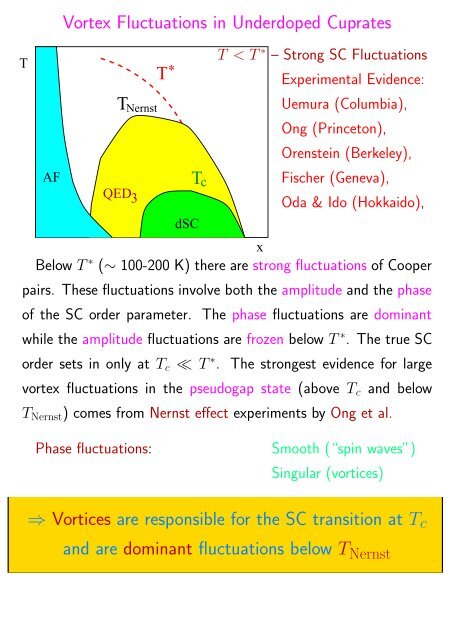QED3 Theory of High Temperature Superconductors ⢠What is the ...
QED3 Theory of High Temperature Superconductors ⢠What is the ...
QED3 Theory of High Temperature Superconductors ⢠What is the ...
You also want an ePaper? Increase the reach of your titles
YUMPU automatically turns print PDFs into web optimized ePapers that Google loves.
T<br />
Vortex Fluctuations in Underdoped Cuprates<br />
T<br />
Nernst<br />
T<br />
AF<br />
QED 3<br />
T c<br />
dSC<br />
*<br />
T < T ∗ – Strong SC Fluctuations<br />
Experimental Evidence:<br />
Uemura (Columbia),<br />
Ong (Princeton),<br />
Orenstein (Berkeley),<br />
F<strong>is</strong>cher (Geneva),<br />
Oda & Ido (Hokkaido),<br />
Below T ∗ (∼ 100-200 K) <strong>the</strong>re are strong fluctuations <strong>of</strong> Cooper<br />
pairs. These fluctuations involve both <strong>the</strong> amplitude and <strong>the</strong> phase<br />
<strong>of</strong> <strong>the</strong> SC order parameter. The phase fluctuations are dominant<br />
while <strong>the</strong> amplitude fluctuations are frozen below T ∗ . The true SC<br />
order sets in only at T c ≪ T ∗ . The strongest evidence for large<br />
vortex fluctuations in <strong>the</strong> pseudogap state (above T c and below<br />
T Nernst ) comes from Nernst effect experiments by Ong et al.<br />
x<br />
Phase fluctuations:<br />
Smooth (“spin waves”)<br />
Singular (vortices)<br />
⇒ Vortices are responsible for <strong>the</strong> SC transition at T c<br />
and are dominant fluctuations below T Nernst
















